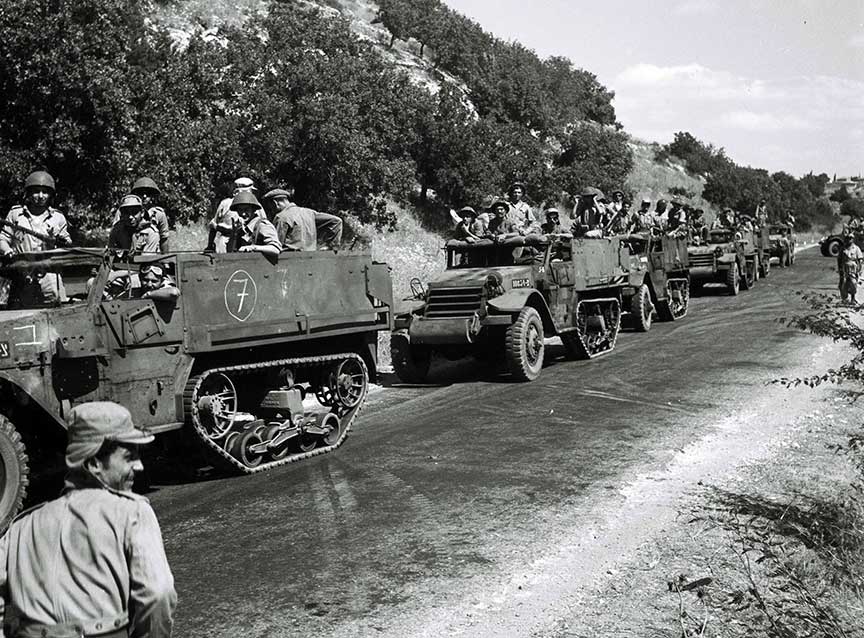War of Independance - 1948

IDF Halftracks of the 8th Brigade
From the moment the State of Israel came into being Arab Armies invaded. All were repulsed and when the war ended Israel had expanded on the original borders of the partition plan. However the price was high 6,000 Israelis died.
As the end of the British Mandate drew near, the Arab States prepared their armies to attack. What motivated this aggression? Azzam Pasha, Head of the Arab League declared: “It does not matter how many Jews there are we will sweep them into the sea.” Syrian President Shukri al-/Quwwatli asserted, “Overcoming the Crusades took a long time, but the result was victory. There is no doubt that history is repeating itself.”
Following the Declaration of Independence, Israel faced invasion by the armies of all the surrounding Arab countries. At that moment, the Israeli Army numbered 30,000 troops, lacking any armored or other heavy equipment, and its Air Force was limited to just a few Piper Cubs. Though the situation evolved in the subsequent weeks, initially, the regular Arab armies held an overwhelming advantage, both in terms of manpower and equipment.
The Arab armies launched invasions from all directions. In the North, the Lebanese Army seized the Malkiyah border crossing. Syrian forces targeted the area around the Sea of Galilee, advancing towards Kibbutz Degania, only to be repelled. Iraqis forces initiated an assault across the Jordan River near the town of Besian, but were forced to retreat. They subsequently repositioned their troops to adopt defensive positions in Samaria.
The most significant threat came from the advance of the Egyptian forces. The Egyptian Army split into two columns: one pushed through the Negev Desert, heading towards Jerusalem, halting near the city at Kibbutz Ramat Rachel. The second column advanced along the coastal road towards Tel Aviv. For five critical days, the Egyptian Army was delayed by the brave defense of Kfar Mordechai. The Egyptians next encountered armed resistance at Kibbutz Negba, which they eventually circumvented. Egyptian forces then advanced to where Ashdod is located today and paused.
On May 29, Israeli forces launched a counter-offensive, which was divided into two segments— with both aerial and ground assaults. In the aerial component, four Israeli Messershmitt aircraft, the first ones to be assembled after their acquisition from Czechoslakia, were deployed to strike Egyptian positions. One of the pilots was Ezer Weizmann, who went on to be the commander of the Air Force and President of Israel. Weizmann stated:
As soon as we got up into the air, we could see the see the anti-aircraft fire directed us from Ashdod, We swung out to sea, climbing to 7,000 feet, and swooped towards the Egyptian column. The sight took my breadth away. The Egyptian Army in all its power and glory, was spread along the road and I knew more or less what stood between it and Tel Aviv two and half companies of the Givati Brigade, anxiety stricken and exhausted. I must confess I had a profound sense of fulfilling a great mission.”
The Israeli aerial mission had a strong psychological impact on the Egyptians, who felt they had lost air support. For Israel’s troops the effect was the opposite; for the first time during the war they felt they had effective air support.
The second component of Israel’s counter-attack was a ground offensive, which the Egyptians repelled. However, this encounter persuaded the Egyptians that they were over extended, leading them to abandon any further attempts to advance.
The Arab Legion of Jordan, another formidable force, also invaded the nascent state of Israel. The Arab Legion was the best-equipped and trained Arab Army, as the Legion was commanded by experienced British officers. Fortunately for Israel, the Legion was relatively small, with 4,500 troops. Israel had been hoped that the Legion would stay out of the war completely. Secret negotiations had been ongoing between the Jewish Agency and the Hashemite King Abdullah. But ultimately, the King feared that not joining the other Arab states would make his position in the Arab world untenable. On the day that Israel’s independence was declared, the Arab Legion captured the Jewish settlements in the Etzion Bloc, located between Hebron and Bethlehem. However, the critical confrontation was the battle for Jerusalem.
On May 28, the defenders of the ancient Jewish Quarter surrendered, overwhelmed by the superior numbers and weaponry of their adversaries. However, the western portion of the city was successfully defended, though it remained under virtual siege. As a result, Jewish residents of Western Jerusalem were plunged into dire straits. They faced acute shortages of food, water, and arms. The critical road linking the coastal plain to Jerusalem had been blocked since the beginning of the war, when the Arab Legion occupied the Latrun fortress (having received it from the British.) Positioned on a strategic high point, Latrun dominated the route to Jerusalem, at the point where the road began the initial ascent from the plain up through the mountains.
Control of Latrun meant control over access to Jerusalem. Beginning on May 25, Israeli forces launched repeated attempts to capture the fortress, only to end in failure. In a fortunate turn of events, Colonel David Marcus, an American Machal volunteer, helped uncover an alternate, less conspicuous, narrow path to Jerusalem. Under Marcus’ direction, the path was rapidly widened into a makeshift road, just in time to relieve the siege of Jerusalem before the first truce went into effect.
 >
>